seat adjustment JEEP CHEROKEE 2018 Owner handbook (in English)
[x] Cancel search | Manufacturer: JEEP, Model Year: 2018, Model line: CHEROKEE, Model: JEEP CHEROKEE 2018Pages: 312, PDF Size: 4.91 MB
Page 13 of 312
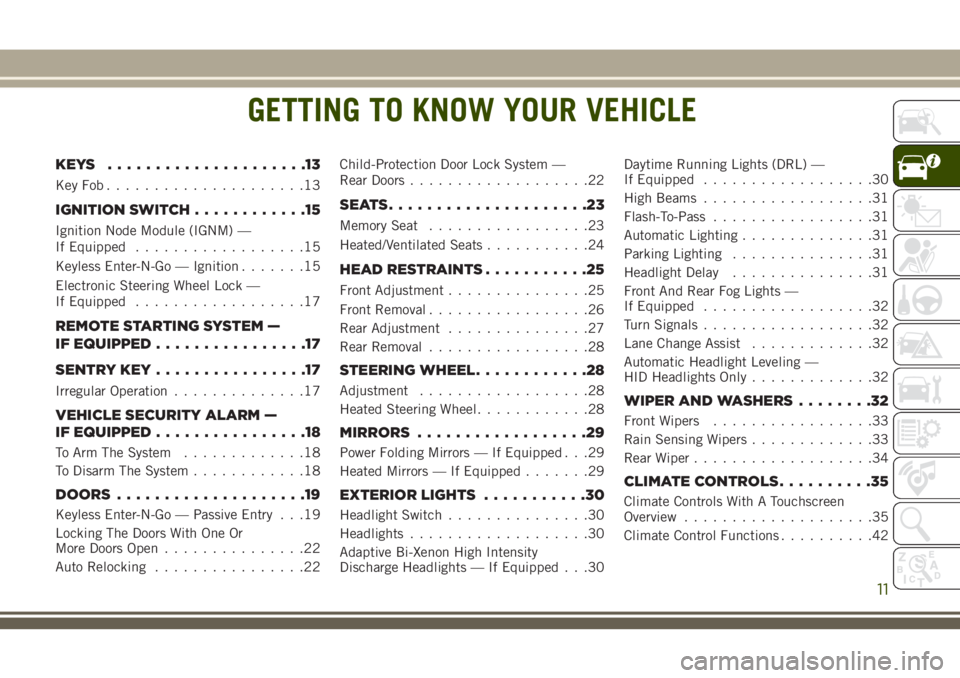
GETTING TO KNOW YOUR VEHICLE
KEYS .....................13
KeyFob.....................13
IGNITION SWITCH............15
Ignition Node Module (IGNM) —
If Equipped..................15
Keyless Enter-N-Go — Ignition .......15
Electronic Steering Wheel Lock —
If Equipped ..................17
REMOTE STARTING SYSTEM —
IF EQUIPPED ................17
SENTRY KEY ................17
Irregular Operation ..............17
VEHICLE SECURITY ALARM —
IF EQUIPPED................18
To Arm The System .............18
To Disarm The System ............18
DOORS....................19
Keyless Enter-N-Go — Passive Entry . . .19
Locking The Doors With One Or
More Doors Open ...............22
Auto Relocking ................22 Child-Protection Door Lock System —
Rear Doors
...................22
SEATS.....................23
Memory Seat .................23
Heated/Ventilated Seats ...........24
HEAD RESTRAINTS...........25
Front Adjustment...............25
Front Removal .................26
Rear Adjustment ...............27
Rear Removal .................28
STEERING WHEEL ............28
Adjustment..................28
Heated Steering Wheel ............28
MIRRORS..................29
Power Folding Mirrors — If Equipped . . .29
Heated Mirrors — If Equipped .......29
EXTERIOR LIGHTS...........30
Headlight Switch...............30
Headlights ...................30
Adaptive Bi-Xenon High Intensity
Discharge Headlights — If Equipped . . .30 Daytime Running Lights (DRL) —
If Equipped
..................30
High Beams ..................31
Flash-To-Pass .................31
Automatic Lighting ..............31
Parking Lighting ...............31
Headlight Delay ...............31
Front And Rear Fog Lights —
If Equipped ..................32
Turn Signals ..................32
Lane Change Assist .............32
Automatic Headlight Leveling —
HID Headlights Only .............32
WIPER AND WASHERS ........32
Front Wipers.................33
Rain Sensing Wipers .............33
Rear Wiper ...................34
CLIMATE CONTROLS ..........35
Climate Controls With A Touchscreen
Overview....................35
Climate Control Functions ..........42
GETTING TO KNOW YOUR VEHICLE
11
Page 27 of 312
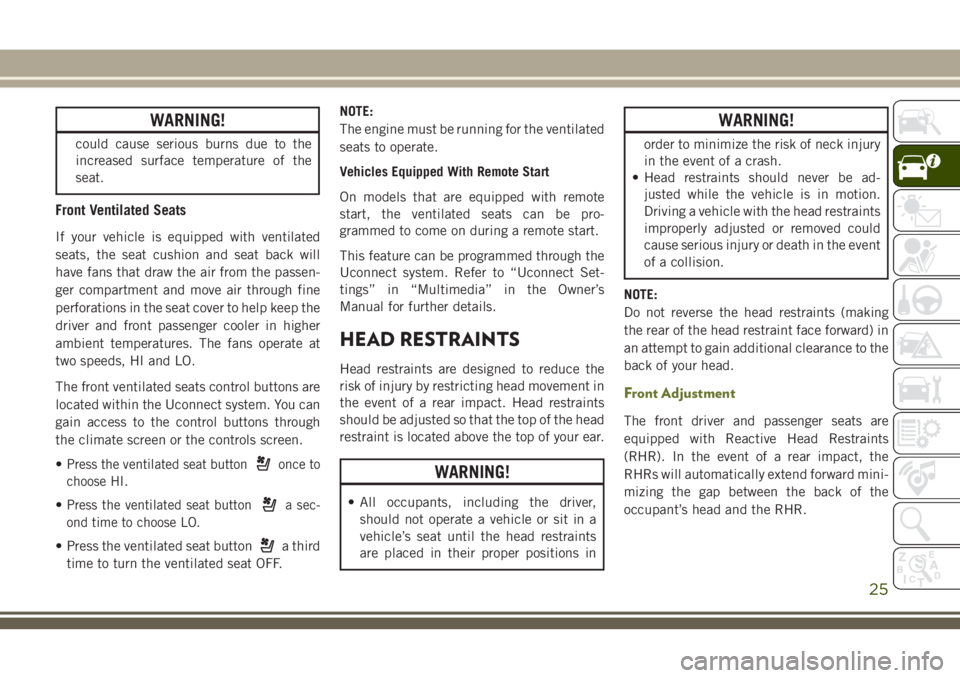
WARNING!
could cause serious burns due to the
increased surface temperature of the
seat.
Front Ventilated Seats
If your vehicle is equipped with ventilated
seats, the seat cushion and seat back will
have fans that draw the air from the passen-
ger compartment and move air through fine
perforations in the seat cover to help keep the
driver and front passenger cooler in higher
ambient temperatures. The fans operate at
two speeds, HI and LO.
The front ventilated seats control buttons are
located within the Uconnect system. You can
gain access to the control buttons through
the climate screen or the controls screen.
•
Press the ventilated seat buttononce to
choose HI.
•Press the ventilated seat buttona sec-
ond time to choose LO.
• Press the ventilated seat buttona third
time to turn the ventilated seat OFF. NOTE:
The engine must be running for the ventilated
seats to operate.
Vehicles Equipped With Remote Start
On models that are equipped with remote
start, the ventilated seats can be pro-
grammed to come on during a remote start.
This feature can be programmed through the
Uconnect system. Refer to “Uconnect Set-
tings” in “Multimedia” in the Owner’s
Manual for further details.
HEAD RESTRAINTS
Head restraints are designed to reduce the
risk of injury by restricting head movement in
the event of a rear impact. Head restraints
should be adjusted so that the top of the head
restraint is located above the top of your ear.
WARNING!
• All occupants, including the driver,
should not operate a vehicle or sit in a
vehicle’s seat until the head restraints
are placed in their proper positions in
WARNING!
order to minimize the risk of neck injury
in the event of a crash.
• Head restraints should never be ad-
justed while the vehicle is in motion.
Driving a vehicle with the head restraints
improperly adjusted or removed could
cause serious injury or death in the event
of a collision.
NOTE:
Do not reverse the head restraints (making
the rear of the head restraint face forward) in
an attempt to gain additional clearance to the
back of your head.
Front Adjustment
The front driver and passenger seats are
equipped with Reactive Head Restraints
(RHR). In the event of a rear impact, the
RHRs will automatically extend forward mini-
mizing the gap between the back of the
occupant’s head and the RHR.
25
Page 28 of 312
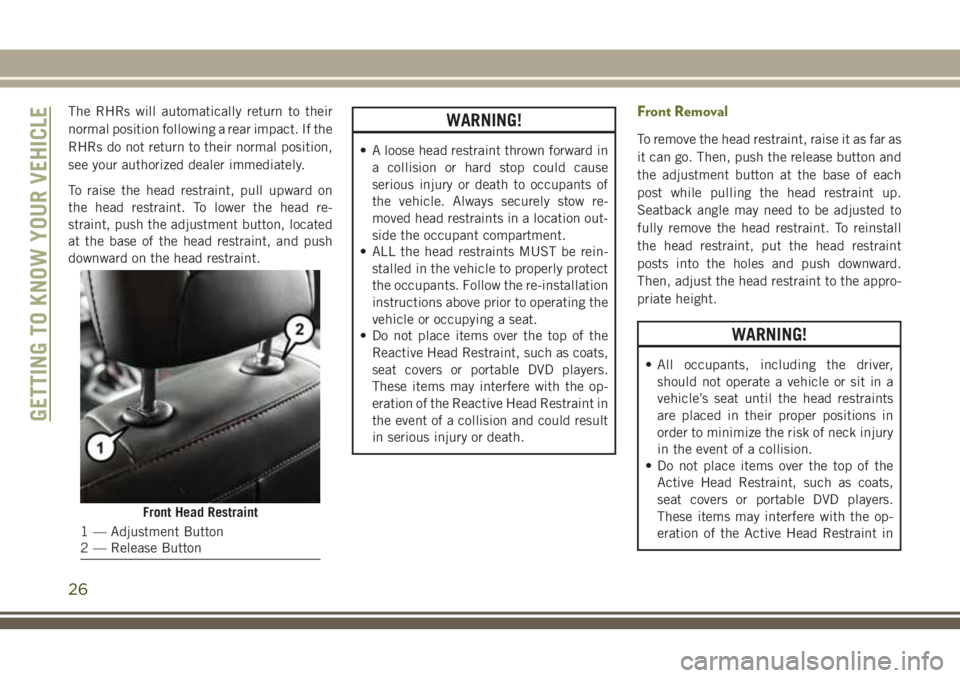
The RHRs will automatically return to their
normal position following a rear impact. If the
RHRs do not return to their normal position,
see your authorized dealer immediately.
To raise the head restraint, pull upward on
the head restraint. To lower the head re-
straint, push the adjustment button, located
at the base of the head restraint, and push
downward on the head restraint.WARNING!
• A loose head restraint thrown forward ina collision or hard stop could cause
serious injury or death to occupants of
the vehicle. Always securely stow re-
moved head restraints in a location out-
side the occupant compartment.
• ALL the head restraints MUST be rein-
stalled in the vehicle to properly protect
the occupants. Follow the re-installation
instructions above prior to operating the
vehicle or occupying a seat.
• Do not place items over the top of the
Reactive Head Restraint, such as coats,
seat covers or portable DVD players.
These items may interfere with the op-
eration of the Reactive Head Restraint in
the event of a collision and could result
in serious injury or death.
Front Removal
To remove the head restraint, raise it as far as
it can go. Then, push the release button and
the adjustment button at the base of each
post while pulling the head restraint up.
Seatback angle may need to be adjusted to
fully remove the head restraint. To reinstall
the head restraint, put the head restraint
posts into the holes and push downward.
Then, adjust the head restraint to the appro-
priate height.
WARNING!
• All occupants, including the driver,should not operate a vehicle or sit in a
vehicle’s seat until the head restraints
are placed in their proper positions in
order to minimize the risk of neck injury
in the event of a collision.
• Do not place items over the top of the
Active Head Restraint, such as coats,
seat covers or portable DVD players.
These items may interfere with the op-
eration of the Active Head Restraint in
Front Head Restraint
1 — Adjustment Button
2 — Release Button
GETTING TO KNOW YOUR VEHICLE
26
Page 29 of 312

WARNING!
the event of a collision and could result
in serious injury or death.
• Active Head Restraints may be deployed
if they are struck by an object such as a
hand, foot or loose cargo. To avoid acci-
dental deployment of the Active Head
Restraint ensure that all cargo is se-
cured, as loose cargo could contact the
Active Head Restraint during sudden
stops. Failure to follow this warning
could cause personal injury if the Active
Head Restraint is deployed.
Rear Adjustment
The rear outboard head restraints have three
positions up, mid and down. The center head
restraint has only two positions, up and down.
When the center seat is being occupied, the
head restraint should be in the raised posi-
tion. When there is no occupant in the center
seat, the head restraint can be lowered for
maximum visibility for the driver. To raise the head restraint, pull upward on the
head restraint. To lower the head restraint,
push the adjustment button, located at the
base of the head restraint, and push down-
ward on the head restraint.
WARNING!
Sitting in a seat with the head restraint in its
lowered position could result in serious in-
jury or death in a collision. Always make
Outboard Head Restraint
1 — Release Button
2 — Adjustment Button
Center Head Restraint
1— Adjustment Button
2— Release Button
27
Page 30 of 312
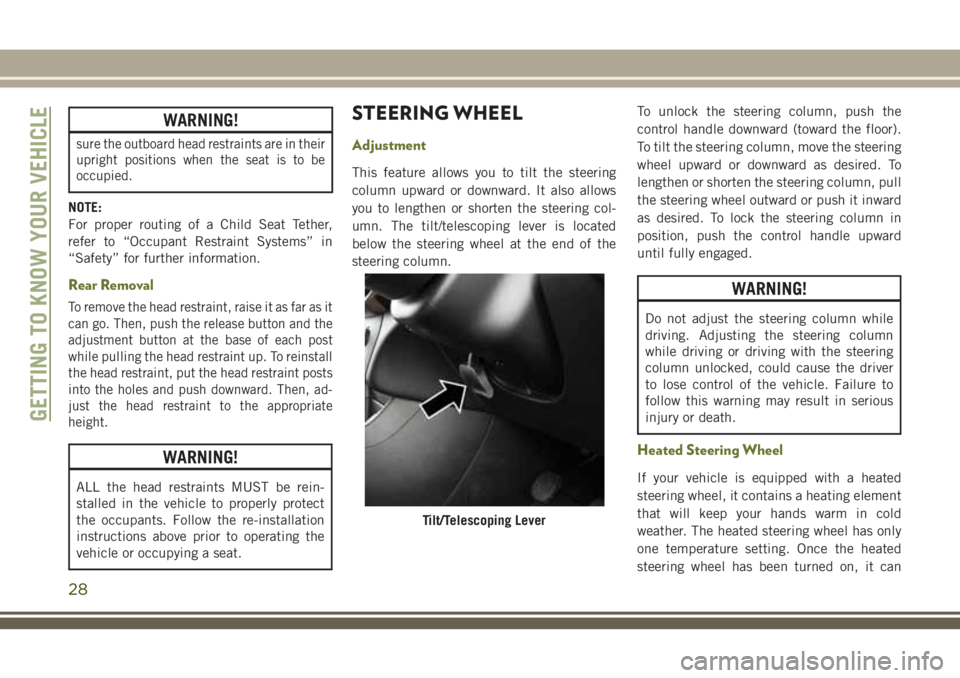
WARNING!
sure the outboard head restraints are in their
upright positions when the seat is to be
occupied.
NOTE:
For proper routing of a Child Seat Tether,
refer to “Occupant Restraint Systems” in
“Safety” for further information.
Rear Removal
To remove the head restraint, raise it as far as it
can go. Then, push the release button and the
adjustment button at the base of each post
while pulling the head restraint up. To reinstall
the head restraint, put the head restraint posts
into the holes and push downward. Then, ad-
just the head restraint to the appropriate
height.
WARNING!
ALL the head restraints MUST be rein-
stalled in the vehicle to properly protect
the occupants. Follow the re-installation
instructions above prior to operating the
vehicle or occupying a seat.
STEERING WHEEL
Adjustment
This feature allows you to tilt the steering
column upward or downward. It also allows
you to lengthen or shorten the steering col-
umn. The tilt/telescoping lever is located
below the steering wheel at the end of the
steering column.To unlock the steering column, push the
control handle downward (toward the floor).
To tilt the steering column, move the steering
wheel upward or downward as desired. To
lengthen or shorten the steering column, pull
the steering wheel outward or push it inward
as desired. To lock the steering column in
position, push the control handle upward
until fully engaged.
WARNING!
Do not adjust the steering column while
driving. Adjusting the steering column
while driving or driving with the steering
column unlocked, could cause the driver
to lose control of the vehicle. Failure to
follow this warning may result in serious
injury or death.
Heated Steering Wheel
If your vehicle is equipped with a heated
steering wheel, it contains a heating element
that will keep your hands warm in cold
weather. The heated steering wheel has only
one temperature setting. Once the heated
steering wheel has been turned on, it can
Tilt/Telescoping Lever
GETTING TO KNOW YOUR VEHICLE
28
Page 95 of 312
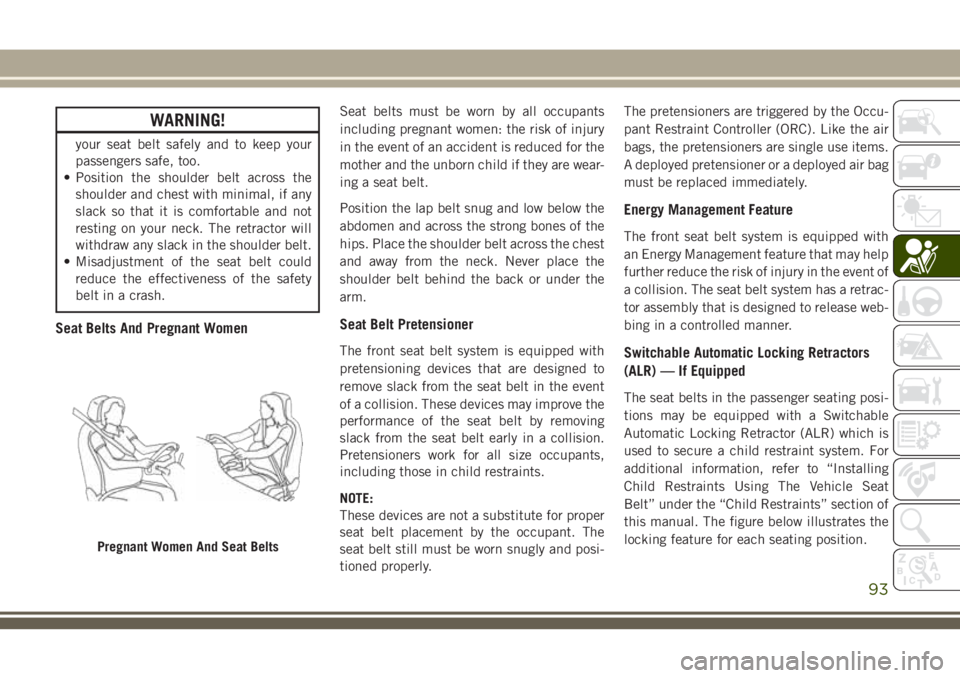
WARNING!
your seat belt safely and to keep your
passengers safe, too.
• Position the shoulder belt across the
shoulder and chest with minimal, if any
slack so that it is comfortable and not
resting on your neck. The retractor will
withdraw any slack in the shoulder belt.
• Misadjustment of the seat belt could
reduce the effectiveness of the safety
belt in a crash.
Seat Belts And Pregnant Women
Seat belts must be worn by all occupants
including pregnant women: the risk of injury
in the event of an accident is reduced for the
mother and the unborn child if they are wear-
ing a seat belt.
Position the lap belt snug and low below the
abdomen and across the strong bones of the
hips. Place the shoulder belt across the chest
and away from the neck. Never place the
shoulder belt behind the back or under the
arm.
Seat Belt Pretensioner
The front seat belt system is equipped with
pretensioning devices that are designed to
remove slack from the seat belt in the event
of a collision. These devices may improve the
performance of the seat belt by removing
slack from the seat belt early in a collision.
Pretensioners work for all size occupants,
including those in child restraints.
NOTE:
These devices are not a substitute for proper
seat belt placement by the occupant. The
seat belt still must be worn snugly and posi-
tioned properly. The pretensioners are triggered by the Occu-
pant Restraint Controller (ORC). Like the air
bags, the pretensioners are single use items.
A deployed pretensioner or a deployed air bag
must be replaced immediately.
Energy Management Feature
The front seat belt system is equipped with
an Energy Management feature that may help
further reduce the risk of injury in the event of
a collision. The seat belt system has a retrac-
tor assembly that is designed to release web-
bing in a controlled manner.
Switchable Automatic Locking Retractors
(ALR) — If Equipped
The seat belts in the passenger seating posi-
tions may be equipped with a Switchable
Automatic Locking Retractor (ALR) which is
used to secure a child restraint system. For
additional information, refer to “Installing
Child Restraints Using The Vehicle Seat
Belt” under the “Child Restraints” section of
this manual. The figure below illustrates the
locking feature for each seating position.
Pregnant Women And Seat Belts
93